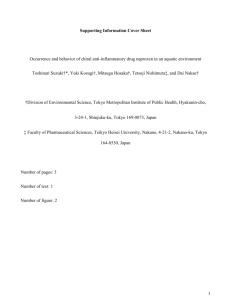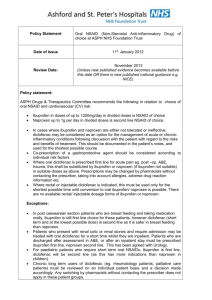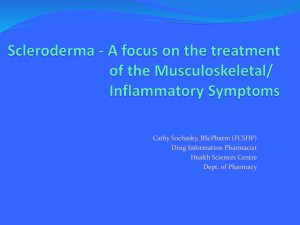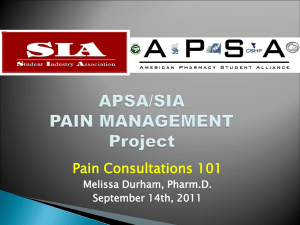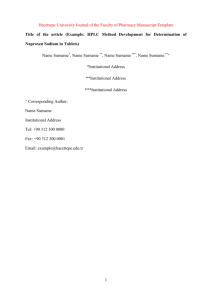A Double-Blind Controlled Trial of a Single Dose Naproxen and an
advertisement
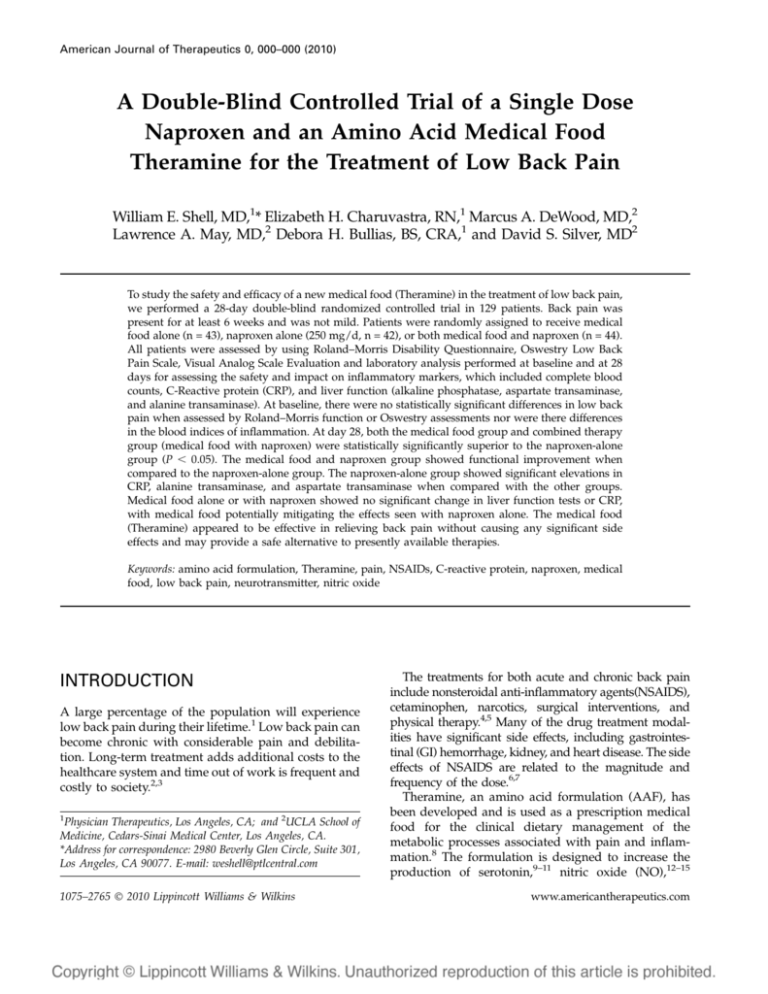
American Journal of Therapeutics 0, 000–000 (2010) A Double-Blind Controlled Trial of a Single Dose Naproxen and an Amino Acid Medical Food Theramine for the Treatment of Low Back Pain William E. Shell, MD,1* Elizabeth H. Charuvastra, RN,1 Marcus A. DeWood, MD,2 Lawrence A. May, MD,2 Debora H. Bullias, BS, CRA,1 and David S. Silver, MD2 To study the safety and efficacy of a new medical food (Theramine) in the treatment of low back pain, we performed a 28-day double-blind randomized controlled trial in 129 patients. Back pain was present for at least 6 weeks and was not mild. Patients were randomly assigned to receive medical food alone (n = 43), naproxen alone (250 mg/d, n = 42), or both medical food and naproxen (n = 44). All patients were assessed by using Roland–Morris Disability Questionnaire, Oswestry Low Back Pain Scale, Visual Analog Scale Evaluation and laboratory analysis performed at baseline and at 28 days for assessing the safety and impact on inflammatory markers, which included complete blood counts, C-Reactive protein (CRP), and liver function (alkaline phosphatase, aspartate transaminase, and alanine transaminase). At baseline, there were no statistically significant differences in low back pain when assessed by Roland–Morris function or Oswestry assessments nor were there differences in the blood indices of inflammation. At day 28, both the medical food group and combined therapy group (medical food with naproxen) were statistically significantly superior to the naproxen-alone group (P , 0.05). The medical food and naproxen group showed functional improvement when compared to the naproxen-alone group. The naproxen-alone group showed significant elevations in CRP, alanine transaminase, and aspartate transaminase when compared with the other groups. Medical food alone or with naproxen showed no significant change in liver function tests or CRP, with medical food potentially mitigating the effects seen with naproxen alone. The medical food (Theramine) appeared to be effective in relieving back pain without causing any significant side effects and may provide a safe alternative to presently available therapies. Keywords: amino acid formulation, Theramine, pain, NSAIDs, C-reactive protein, naproxen, medical food, low back pain, neurotransmitter, nitric oxide INTRODUCTION A large percentage of the population will experience low back pain during their lifetime.1 Low back pain can become chronic with considerable pain and debilitation. Long-term treatment adds additional costs to the healthcare system and time out of work is frequent and costly to society.2,3 1 Physician Therapeutics, Los Angeles, CA; and 2UCLA School of Medicine, Cedars-Sinai Medical Center, Los Angeles, CA. *Address for correspondence: 2980 Beverly Glen Circle, Suite 301, Los Angeles, CA 90077. E-mail: weshell@ptlcentral.com 1075–2765 Ó 2010 Lippincott Williams & Wilkins The treatments for both acute and chronic back pain include nonsteroidal anti-inflammatory agents(NSAIDS), cetaminophen, narcotics, surgical interventions, and physical therapy.4,5 Many of the drug treatment modalities have significant side effects, including gastrointestinal (GI) hemorrhage, kidney, and heart disease. The side effects of NSAIDS are related to the magnitude and frequency of the dose.6,7 Theramine, an amino acid formulation (AAF), has been developed and is used as a prescription medical food for the clinical dietary management of the metabolic processes associated with pain and inflammation.8 The formulation is designed to increase the production of serotonin,9–11 nitric oxide (NO),12–15 www.americantherapeutics.com 2 histamine,16–18 and gamma-aminobutyric acid by providing precursors to these neurotransmitters. The neurotransmitters addressed in this formulation have well-defined and specific roles in the modulation of pain and inflammation. For example, gut serotonin alters platelet aggregation, whereas gut NO specifically reduces erosions induced by NSAIDS.19–21 The formulation contains ingredients that are generally recognized as safe (GRAS) and is regulated by the Food and Drug Administration in the medical food category.22–24 A medical food that is GRAS and effective for its intended use and that has shown the ability to allow a reduction in the dose of NSAIDS used in the treatment of back pain, thereby reducing the side effects of these agents, would be of substantial use. The purpose of this randomized double-blind controlled clinical trial was to compare the effects of the AAF with and without low-dose naproxen in a 28-day study of 129 patients with chronic low back pain. MATERIALS AND METHODS The study involved 129 patients in a 3-arm doubleblind randomized trial comparing naproxen alone (n = 42), AAF alone (n = 43), or the combined use of AAF and naproxen (n = 44). During the washout period, patients taking oral anti-inflammatory or other analgesic medicines discontinued their medication for 5 half lives before randomization. Aspirin ingestion (#325 mg/d) for nonarthritic conditions was allowed and used as a stable background drug. Only acetaminophen (650–1000 mg every 4–6 hours) was used as rescue therapy for pain but never exceeded 4 gm daily. Protocol The study was conducted at 12 sites. At each site, informed consent was obtained, screening procedures were performed, and a washout period was begun. After the washout period, there was a baseline day-1 visit. At that time, a baseline Roland–Morris Disability Questionnaire, an Oswestry Low Back Pain Scale, and a Visual Analog Scale (VAS) evaluation were obtained. In addition, blood was sampled for assessing Creactive protein (CRP), blood count, and blood chemistries. On the day-1 visit, the patients were randomized to 1 of 3 groups: (1) naproxen-alone group, which was treated for 28 days with a 2-capsule dose of an amino acid–like placebo twice daily and naproxen 250 mg/d in the morning (2) AAF-alone group, which was treated with the active AAF at a 2-capsule dose twice daily and a single naproxen-like placebo in the morning, and (3) the combined group (both AAF and American Journal of Therapeutics (2010) 0(0) Shell et al naproxen), which was treated with active AAF at a 2-capsule dose twice daily and 250 mg of an active naproxen in the morning. The active and naproxen tablets were identical, and the AAF active and placebo capsules were identical. On days 7 and 14, the evaluation of VAS and patient medication usage was completed. On day 28, a Roland–Morris Disability Questionnaire, an Oswestry Low Back Pain Scale, a VAS Evaluation, and a patient medication usage evaluation were completed. Blood was again sampled for estimating CRP, blood count, and blood chemistries. Primary endpoints The primary endpoints of the study were pain and disability as measured by the Roland–Morris pain questionnaire and the Oswestry Disability Index.25–29 Patient selection Patients were identified in 12 separate physicians’ offices. Men and nonpregnant, nonlactating women aged between 18 and 75 years were recruited for the study. To be included in the study, patients were required to have back pain lasting ,6 weeks, with pain present on 5 of 7 days during each of the 2 weeks before screening. Patients with a Roland–Morris back pain index .40 of 100 mm on the VAS were included. Finally, patients being treated with psychoactive medication were considered eligible to participate provided the dose remained stable for 3 months before study entry. Exclusion criteria Patients with surgery in the previous 6 months were excluded as were patients with neurologic impairment. Patients with fracture of the spine within the past year and patients receiving oral, intramuscular, or soft tissue injection of corticosteroids within 1 month before screening were excluded. Patients were also excluded if they had a history of GI bleeding, gastric or duodenal ulcer as were patients receiving an epidural injection within 3 months before screening. Patients were also excluded for participation in a prior clinical trial within 1 month of screening for the present study. Finally, patients who used controlled substances or opiate analgesics for .5 days in the month before screening were considered ineligible to participate. Statistical analysis The primary measure of efficacy was the change in awakening stiffness and pain scores obtained from the Roland–Morris Lower Back Pain Scale and the Oswestry Disability Index questionnaire evaluation.25–30 Scores were assigned on study entry (day 0) www.americantherapeutics.com A Double-Blind Trial for Treatment of Back Pain and at study end (day 28). Assuming that larger values are worse, a negative value for the change from baseline score indicates an improvement in the score, and positive values indicate a worsening in the score in percent. Analysis of variance was used (ANOVA) to determine statistical differences among the 3 groups on the study entry and at the completion of treatment. Statistical significance was defined as P # 0.05. An intension to treat analysis was utilized. Of the 129 patients who entered the trial, 126 completed the study. Patients who did not complete were carried forward as an intention to treat. As is shown in Table 1, none of the 3 study groups was statistically different on entry into the trial. Likewise, the laboratory responses assessed in each of the 3 study groups we measured, including CRP and hemoglobin (Hgb), alkaline phosphatase (alk phos), aspartate transaminase (AST), and alanine transaminase (ALT), were not statistically significantly different (Table 1) at baseline. CRP was chosen because it is an acute phase marker of inflammation. The liver enzymes (alk phos, AST, and ALT) were monitored to assess possible liver toxicity due to NSAIDs. Safety There were no adverse events or complications among any of the groups during this 28-day study. There were no GI side effects observed in this cohort. RESULTS 3 For example, The Roland–Morris Index if fell by 65%, and the Oswestry Disability index fell 61% between baseline and day 28 in the AAF/naproxen group. In the AAF-alone group, there was a significant reduction in back pain. Thus, if the AAF was used as either primary therapy or an adjunct to naproxen, low back pain was significantly improved. Low-dose naproxen had no appreciable effect on chronic back pain in 28 days. Similar results were seen on using the VAS scale. C-Reactive protein In the single daily dose of naproxen (Table 3), CRP rose significantly (P , 0.001). In the AAF-alone group, the CRP level fell by 16.7% (P , 0.05). In the group treated with both the AAF and single daily dose of 250 mg of naproxen, CRP fell 78.6% (P , 0.001). Laboratory measurements For participants of the study, no significant differences were found in Hgb, Alk Phos, alanine transaminase, aspartate transaminase among the 3 groups, as shown in Table 1. Throughout the study (Table 3), neither Hgb nor Alk Phos changed significantly among the groups. Both ALT and AST values rose significantly in the naproxen-alone group compared with those in the AAF alone group or the AAF/naproxen-treated cohort. Although there was no clinical deterioration evident, there was laboratory evidence of hepatocellular inflammation if naproxen was used in the absence of active AAF. DISCUSSION Significant changes were observed among the 3 groups after 28 days (Table 2). The Naproxen group remained unchanged from baseline to 28 days when assessed by either the Oswestry Low Back Pain Scale or the Roland–Morris rating scale. There were significant differences in pain reduction in both the AAF-alone group and the amino acid/naproxen treated groups. The data in this study indicate that addressing the dietary management of pain syndromes could allow for the dose reduction of NSAIDs without affecting therapeutic efficacy. Dietary management of disease is an underappreciated option for patients, although it has been in existence for .100 years. Osler31 Table 1. Clinical characteristics at study entry. Mean 6 SD Naproxen alone (n = 42) Oswestry Disability Index Roland–Morris Pain Scale Hgb CRP Alk. Phos. ALT AST www.americantherapeutics.com 29.19 12.90 13.61 1.9 75.04 24.85 20.85 6 6 6 6 6 6 6 7.49 5.14 3.92 1.90 27.1 10.64 7.49 AAF alone (n = 43) 24.21 10.97 13.93 2.36 73.7 25.69 21.84 6 8.09 6 5.42 61.52 6 3.3 6 29.99 6 15.46 6 11.3 Both (n = 44) 27.13 12.38 13.85 3.53 74.2 30.53 25.69 6 6 6 6 6 6 6 8.19 5.31 1.51 5.73 19.16 28.13 15.46 P value NS NS NS NS NS NS NS American Journal of Therapeutics (2010) 0(0) 4 Shell et al Table 2. Primary endpoints percent change from baseline. % Change from baseline Oswestry disability index Roland–Morris Pain index 23.4 232.94 260.47 ,0.05 2.95 244 265 ,0.05 Naproxen AAF Both P value ANOVA prominently emphasized the value of nutrition in his textbooks. Advances in science mandate inclusion of nutrient management of symptoms and disease. Because nutrient management of disease has existed since therapeutic medicine began, evidence-based examples of more modern observations would be useful. For example, Tepaske et al32 administered an arginine-based preparation to patients before cardiac surgery. The clinical outcomes were found to be improved, specifically postoperative creatine clearance and immune function. Fonarow and coworkers33 and Tepaske et al32 demonstrated that administration of amino acid neurotransmitter precursors in patients with congestive heart failure improved clinical outcomes. These are 2 examples of recent observations of the importance of nutrient management of disease. The AAF of neurotransmitter precursors used in this study is designed to elicit neurotransmitter production. The amino acid precursors support the production of neurotransmitters that modulate pain and inflammation. The precursors of serotonin, NO, histamine, and gamma-aminobutyric acid are supplied in this formulation as 5-hydroxytryptophan, arginine, histidine, and glutamine, respectively. These neurotransmitters modulate nociception and inflammation.34–48 Histidine, for example, is converted to histamine, which elicits adrenocorticotropic hormone/cortisol release.49,50 In this study, a single daily dose of 250 mg of naproxen had no effect on chronic back pain over 28 days, a nonsignificant 2.95% increase in the Roland– Morris Index measure of pain was found. The AAF Table 3. Toxicity data percent change from baseline. % Change from baseline CRP Naproxen 184.5 AAF 216.7 Both 278.6 P value ANOVA ,0.01 HB Alk Phos 21.6 21 21.49 ,0.01 1.68 4.75 0.51 NS American Journal of Therapeutics (2010) 0(0) ALT AST 7.4 20.24 2 1.37 214.1 9.96 ,0.05 ,0.05 alone produced a 44% reduction in the Roland–Morris Index and a 33% reduction in the Oswestry index. The AAF with 250 mg of naproxen administered once a day resulted in a 65% reduction in the Roland–Morris Index and a 61% reduction in the Oswestry Index. Back pain is a common concern, affecting up to 90% of people during their lifetime. Nonsteroidal antiinflammatory drugs are the most commonly used drugs in the treatment of pain and inflammation.51–59 However, their use is limited by adverse drug side effects notably GI toxicity.6,60,61–64 The adverse effects of NSAIDS are dose related.65–72 The current advice of the American Geriatrics Society is to restrict or even eliminate NSAIDS in older people. This demographic with the highest incidence of osteoarthritis, back pain, and spinal stenosis is at greatest risk for adverse events. For many of these patients, the only alternative to NSAIDS may be addictive narcotics. The study included 129 patients from 12 sites. The differences in the data were highly statistically significant, but the subjects were limited to 129 patients. Because the ingredients of the AAF are GRAS, a large safety trial would appear to be unnecessary. The single daily dose of naproxen is unlikely to cause liver or kidney damage. Whether the low dose of naproxen would be cardioprotective or whether the low dose of naproxen combined with the AAF would reduce the incidence of GI side effects was not examined. It is interesting to note that tryptophan induces an increase in platelet aggregability, and NO production in the GI tract is known to reduce NSAID-induced mucosal erosion. Anti-inflammatory nonsteroidal drugs with NOproducing precursors attached (NO–NSAIDs) are a new class of drugs.73–77 These compounds have been shown to retain the anti-inflammatory, analgesic, and antipyretic activity with reduced GI toxicity.20,73,78 The use of an NO moiety with an NSAID has been shown in studies to inhibit in vitro T-cell proliferation79 and cytokine production.79 Moreover, NO–NSAIDS have been shown to be GI protective in several models. The AAF used in our study produces NO similarly to the NO–NSAIDS. If the reduction of inflammation and the alteration of nociception in chronic back pain syndromes seen in this study are also associated with the reduction of GI side effects associated with the NO– NSAIDS, the use of an AAF, with or without low-dose naproxen therapy may be useful in the management of back pain. A single daily dose of naproxen increased the CRP by 185%, whereas the administration of AAF reduced the CRP. The AAF administered with naproxen reversed the elevation of CRP. There is a paucity of reported data on the effects of low-dose naproxen on www.americantherapeutics.com A Double-Blind Trial for Treatment of Back Pain CRP. NSAIDs alter the prostaglandin inflammatory cascade but have little effect on other components such as cytokine release and T-cell activation. The ingredients in the AAF are defined by the Food and Drug Administration as GRAS, and in this formulation, the doses fall within the acceptable daily dose for GRAS. The study, however, is underpowered to detect any potential deleterious interaction between the amino acids and naproxen. We could only detect an event of 1 in 129 exposures. We have examined a large number of subjects exposed to the AAF and various NSAIDS, and this manuscript is in preparation. In addition, additional double-blind trials will be necessary to detect potential deleterious interactions. There are limited data, however, to indicate that the provision of neurotransmitter precursors alters the efficiency of pharmaceuticals. The data in this study indicate that the provision of amino acid precursors in a formulation to facilitate neurotransmitter production results in improving the efficiency of pharmaceutical therapy. We postulate that the mechanism is related to improving intracellular metabolic function rather than having any effect on the drug itself. This may be a new approach to a long-standing therapy. REFERENCES 1. Cassidy JD, Cote P, Carroll LJ, et al. Incidence and course of low back pain episodes in the general population. Spine. 2005;30:2817–2823. 2. Sleed M, Eccleston C, Beecham J, et al. The economic impact of chronic pain in adolescence: methodological considerations and a preliminary costs-of-illness study. Pain. 2005;119:183–190. 3. van Leeuwen MT, Blyth FM, March LM, et al. Chronic pain and reduced work effectiveness: the hidden cost to Australian employers. Eur J Pain. 2006;10:161–166. 4. McCarberg BH. Acute back pain: benefits and risks of current treatments. Curr Med Res Opin. 2010;26:179–190. 5. Last AR, Hulbert K. Chronic low back pain: evaluation and management. Am Fam Phys. 2009;79:1067–1074. 6. Hunt RH, Harper S, Watson DJ, et al. The gastrointestinal safety of the COX-2 selective inhibitor etoricoxib assessed by both endoscopy and analysis of upper gastrointestinal events. Am J Gastroent. 2003;98:1725–1733. 7. Uribe A, Johansson C, Slezak P, et al. Ulcerations of the colon associated with naproxen and acetylsalicylic acid treatment. Gastroint Endosc. 1986;32:242–244. 8. Shell W, Bullias D, Charuvastra E, et al. A randomized, placebo-controlled trial of an amino acid preparation on timing and quality of sleep. Am J Ther. 2010;17:133–139. 9. McCleane G. Antidepressants as analgesics. CNS Drugs. 2008;22:139–156. 10. Gajraj NM. Pregabalin: its pharmacology and use in pain management. Anesth Analg. 2007;105:1805–1815. www.americantherapeutics.com 5 11. Dworkin RH, O’Connor AB, Backonja M, et al. Pharmacologic management of neuropathic pain: evidence-based recommendations. Pain. 2007;132:237–251. 12. Tepper SJ, Rapoport A, Sheftell F. The pathophysiology of migraine. Neurolog. 2001;7:279–286. 13. Chevlen E. Opioids: a review. Curr Pain Headache Rep. 2003;7:15–23. 14. Goldberg SH, Von Feldt JM, Lonner JH. Pharmacologic therapy for osteoarthritis. Am J Orthop. 2002;31:673–680. 15. Dixit RK, Bhargava VK. Neurotransmitter mechanisms in gabapentin antinociception. Pharmacology. 2002;65:198–203. 16. Oluyomi AO, Hart SL. Involvement of histamine in naloxone-resistant and naloxone-sensitive models of swim stress-induced antinociception in the mouse. Neuropharmacology. 1991;30:1021–1027. 17. Russell IJ, Michalek JE, Vipraio GA, et al. Serum amino acids in fibrositis/fibromyalgia syndrome. J Rheumatol Suppl. 1989;19:158–163. 18. Gross PM. Cerebral histamine: indications for neuronal and vascular regulation. J Cereb Blood Flow Metab. 1982;2: 3–23. 19. Nemmani KV, Mali SV, Borhade N, et al. NO-NSAIDs: gastric-sparing nitric oxide-releasable prodrugs of nonsteroidal anti-inflammatory drugs. Bioorg Med Chem Lett. 2009;19:5297–5301. 20. Wallace JL. Nitric oxide, aspirin-triggered lipoxins and NO-aspirin in gastric protection. Inflamm Aller Drug Targets. 2006;5:133–137. 21. Walley M, Hotz-Behofsits C, Simpson R, et al. Nitric oxide: potential role for reducing gastro-enteropathy. Inflammopharmacology. 2003;11:429–436. 22. Morgan SL, Baggott JE. Medical foods: products for the management of chronic diseases. Nutr Rev. 2006;64: 495–501. 23. Czap A. The FDA, medical foods, and patents. Altern Med Rev. 2002;7:367–368. 24. Mueller C, Nestle M. Regulation of medical foods: toward a rational policy. Nutr Clin Pract. 1995;10:8–15. 25. Bannwarth B, Allaert FA, Avouac B, et al. A randomized, double-blind, placebo controlled triphosphate in study of oral adenosine subacute low back pain. J Rheumatol. 2005; 32:1114–1117. 26. Bess S, Boachie-Adjei O, Burton D, et al. Pain and disability determine treatment modality for older patients with adult scoliosis, while deformity guides treatment for younger patients. Spine (Phila Pa 1976). 2009;34: 2186–2190. 27. Cambron JA, Gudavalli MR, Hedeker D, et al. One-year follow-up of a randomized clinical trial comparing flexion distraction with an exercise program for chronic low-back pain. J Altern Compl Med. 2006;12:659–668. 28. Chen C, Hogg-Johnson S, Smith P. The recovery patterns of back pain among workers with compensated occupational back injuries. Occup Environ Med. 2007;64:534–540. 29. Demoulin C, Ostelo R, Knottnerus JA, et al. What factors influence the measurement properties of the RolandMorris disability questionnaire? Eur J Pain. 2010;14: 200–206. American Journal of Therapeutics (2010) 0(0) 6 30. Frost H, Lamb SE, Stewart-Brown S. Responsiveness of a patient specific outcome measure compared with the Oswestry Disability Index v2.1 and Roland and Morris Disability Questionnaire for patients with subacute and chronic low back pain. Spine (Phila Pa 1976). 2008;33: 2450–2457. 31. Osler W. The Principles and Practice of Medicine (1882). Leslie B. Adams, JR, MA, JD, UD. Delanco, NJ. Copyright 1978. 32. Tepaske R, Velthuis H, Oudemans-van Straaten HM, et al. Effect of preoperative oral immune-enhancing nutritional supplement on patients at high risk of infection after cardiac surgery: a randomised placebo-controlled trial. Lancet. 2001;358:696–701. 33. Kalantar-Zadeh K, Anker SD, Horwich TB, et al. Nutritional and anti-inflammatory interventions in chronic heart failure. Am J Cardiol. 2008;101:E89–E103. 34. Abbott FV, Young SN. The effect of tryptophan supplementation on autotomy induced by nerve lesions in rats. Pharmacol Biochem Behav. 1991;40:301–304. 35. Aghabeigi B. The pathophysiology of pain. Br Dent J. 1992;173:91–97. 36. Akunne HC, Soliman KF. Serotonin modulation of pain responsiveness in the aged rat. Pharmacol Biochem Behav. 1994;48:411–416. 37. Batmanghelidj F. Pain: a need for paradigm change. Anticancer Res. 1987;7:971–989. 38. Ceccherelli F, Costa C, Ischia S, et al. Cerebral tryptophan metabolism in humans in relation to malignant pain. Funct Neurol. 1989;4:341–353. 39. Contino MI, Bausano G. [Nutritional approach to the therapy of pain: recent findings]. Recent Prog Med. 1985; 76:472–475. 40. Delgado PL. Common pathways of depression and pain. J Clin Psychiatry. 2004;65(Suppl 12):16–19. 41. Aley KO, McCarter G, Levine JD. Nitric oxide signaling in pain and nociceptor sensitization in the rat. J Neurosci. 1998;18:7008–7014. 42. Anbar M, Gratt BM. Role of nitric oxide in the physiopathology of pain. J Pain Sympt Manag. 1997;14:225–254. 43. Devulder JE. Could nitric oxide be an important mediator in opioid tolerance and morphine side effects? J Clin Anesth. 2002;14:81–82. 44. Fiorucci S, Antonelli E, Burgaud JL, et al. Nitric oxidereleasing NSAIDs: a review of their current status. Drug Saf. 2001;24:801–811. 45. Kindgen-Milles D, Arndt JO. Nitric oxide as a chemical link in the generation of pain from veins in humans. Pain. 1996;64:139–142. 46. Bennett A. The role of biochemical mediators in peripheral nociception and bone pain. Cancer Surv. 1988;7:55–67. 47. Dray A. Inflammatory mediators of pain. Br J Anaesth. 1995;75:125–131. 48. Keele CA. The chemistry of pain production. Proc R Soc Med. 1967;60:419–422. 49. Feigelson M. Hypophyseal regulation of hepatic histidase during postnatal development and adulthood. II. Pituitary-estrogen interrelationship. Biochem Biophys Acta. 1971;230:309–318. American Journal of Therapeutics (2010) 0(0) Shell et al 50. Kansal VK, Wagle DS. Studies on the action of hormones on the intestinal transport of l-histidine. Ind J Physiol Pharmacol. 1975;19:28–33. 51. Barkin RL. Nonopiod analgesics for osteoarthritis: availability of topical NSAIDs. J Pain Palliat Care Pharmacother. 2010 ;24:180–181. 52. Chou R. Pharmacological management of low back pain. Drugs. 2010;70:387–402. 53. Bach SM, Holten KB. Guideline update: what’s the best approach to acute low back pain? J Fam Pract. 2009;58:E1. 54. Romano CL, Romano D, Bonora C, et al. Pregabalin, celecoxib, and their combination for treatment of chronic low-back pain. J Orthop Traumatol. 2009;10:185–191. 55. Hancock MJ, Maher CG, Latimer J, et al. Can predictors of response to NSAIDs be identified in patients with acute low back pain? Clin J Pain. 2009;25:659–665. 56. Kroenke K, Krebs EE, Bair MJ. Pharmacotherapy of chronic pain: a synthesis of recommendations from systematic reviews. Gen Hosp Psychiatry. 2009;31:206–219. 57. Kuritzky L. Current management of acute musculoskeletal pain in the ambulatory care setting. Am J Ther. 2008; 15(Suppl 10):S7–S11. 58. Rossignol M, Abouelfath A, Lassalle R, et al. The CADEUS study: burden of nonsteroidal anti-inflammatory drug (NSAID) utilization for musculoskeletal disorders in blue collar workers. Br J Clin Pharmacol. 2009;67:118–124. 59. Roelofs PD, Deyo RA, Koes BW, et al. Non-steroidal antiinflammatory drugs for low back pain. Cochrane Database Syst Rev. 2008;(1):CD000396. 60. Chan FK, Chung SC, Suen BY, et al. Preventing recurrent upper gastrointestinal bleeding in patients with Helicobacter pylori infection who are taking low-dose aspirin or naproxen. N Engl J Med. 2001;344:967–973. 61. Laine L, Smith R, Min K, et al. Systematic review: the lower gastrointestinal adverse effects of non-steroidal anti-inflammatory drugs. Aliment Pharmacol Ther. 2006;24: 751–767. 62. Mahajan SK, Vaidya P, Sood BR, et al. Duodenal diverticular haemorrhage in a patient taking NSAID. J Assoc Phys India. 2003;51:416–418. 63. Papich MG. Principles of analgesic drug therapy. Sem Vet Med Surg (Small Anim). 1997;12:80–93. 64. Sweet BV, Townsend KA, Tsai CY. Risk assessment of NSAID-induced gastrointestinal toxicity in ambulatory care patients. Am J Health Syst Pharm. 2004;61:1917–1921. 65. Baum K, Engels B, Vogtle-Junkert U, et al. High dose ibuprofen in low back pain. Fortschr Med. 1997;115: 51–52. 66. Becker MC, Wang TH, Wisniewski L, et al. Rationale, design, and governance of Prospective Randomized Evaluation of Celecoxib Integrated Safety versus Ibuprofen Or Naproxen (PRECISION), a cardiovascular end point trial of nonsteroidal antiinflammatory agents in patients with arthritis. Am Heart J. 2009;157:606–612. 67. Curtis SP, Ng J, Yu Q, et al. Renal effects of etoricoxib and comparator nonsteroidal anti-inflammatory drugs in controlled clinical trials. Clin Ther. 2004;26:70–83. www.americantherapeutics.com A Double-Blind Trial for Treatment of Back Pain 68. Devogelaer JP, Dreiser RL, Abadie E, et al. Guidelines for clinical studies assessing the efficacy of drugs for the management of acute low back pain. Clin Exp Rheumatol. 2003;21:691–694. 69. Gotzsche PC. Review of dose–response studies of NSAIDs in rheumatoid arthritis. Dan Med Bull. 1989;36: 395–399. 70. Katz N, Ju WD, Krupa DA, et al. Efficacy and safety of rofecoxib in patients with chronic low back pain: results from two 4-week, randomized, placebo-controlled, parallel-group, double-blind trials. Spine (Phila Pa 1976). 2003;28:851–858. 71. Lanas A. Nonsteroidal anti-inflammatory drugs, low-dose aspirin, and potential ways of reducing the risk of complications. Eur J Gastroenterol Hepatol. 2001;13:623–626. 72. Porter RS. Factors determining efficacy of NSAIDs. Drug Intell Clin Pharm. 1984;18:42–51. 73. Fiorucci S, Antonelli E. NO-NSAIDs: from inflammatory mediators to clinical readouts. Inflamm Allergy Drug Targets. 2006;5:129–131. www.americantherapeutics.com 7 74. Cirino G, Distrutti E, Wallace JL. Nitric oxide and inflammation. Inflamm Allergy Drug Targets. 2006;5: 115–119. 75. Whittle BJ. Nitric oxide-modulating agents for gastrointestinal disorders. Expert Opin Invest Drugs. 2005;14: 1347–1358. 76. Velazquez C, Praveen Rao PN, Knaus EE. Novel nonsteroidal antiinflammatory drugs possessing a nitric oxide donor diazen-1-ium-1,2-diolate moiety: design, synthesis, biological evaluation, and nitric oxide release studies. J Med Chem. 2005;48:4061–4067. 77. Whittle BJ. Cyclooxygenase and nitric oxide systems in the gut as therapeutic targets for safer anti-inflammatory drugs. Curr Opin Pharmacol. 2004;4:538–545. 78. Wallace JL. Building a better aspirin: gaseous solutions to a century-old problem. Br J Pharmacol. 2007;152:421–428. 79. Cicala C, Ianaro A, Fiorucci S, et al. NO-naproxen modulates inflammation, nociception and downregulates T cell response in rat Freund’s adjuvant arthritis. Br J Pharmacol. 2000;130:1399–1405. American Journal of Therapeutics (2010) 0(0)
